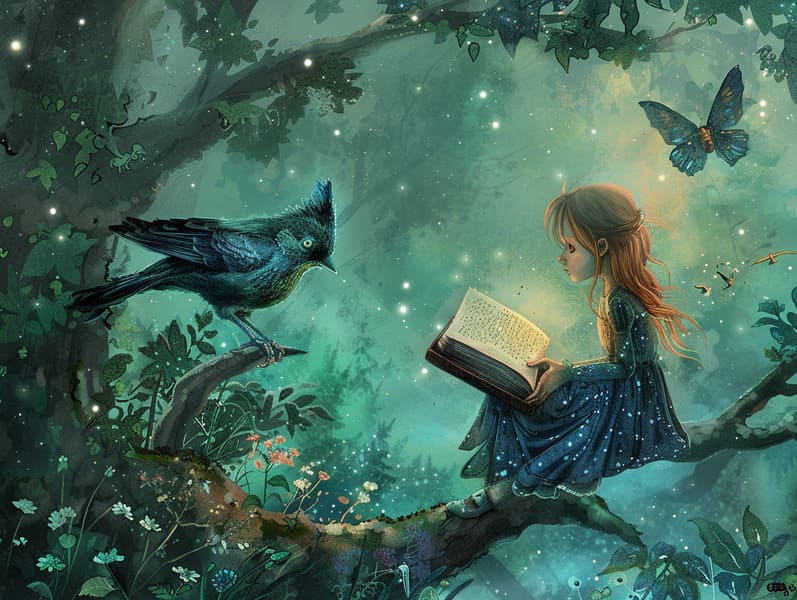The Evolution of Mythical Fairy Tales with Its Undying Appeal.
The Evolution of Mythical Fairy Tales with Its Undying Appeal.
Blog Article

Short fairy tales have enduring presence. These stories have been shared from one generation to the next long before they were ever documented. They sprang from a variety of traditions, including African traditions. They were initially transmitted among elders, often carrying themes and messages concerning the societal norms and beliefs of the time.
The Grimm brothers, Jacob and Wilhelm Grimm, were among the first to assemble many of these beloved narratives. Their published works, "Grimm's Fables," included narratives like "Ashenputtel," "The Bread Crumb Trail," and "Schneewittchen," which have since become essentials in the world of children's fairy tales. Similarly, Hans Andersen's delightful stories, such as "The Little Mermaid," and "The Little Duckling," have captured hearts worldwide, guaranteeing their place in the pantheon of timeless fairy tales.
Despite being ancient, fairy tales remain as relevant as ever, especially as children's bedtime stories. These delightful tales are now available in different formats, including vibrantly illustrated books, fantastical animations, and internet fairy tales.
Their lasting appeal can be linked to several magical reasons:
Significant Morals: Old fairy tales often whisper important moral lessons. Tales like "The Wolf and the Liar" teach the value of sincerity, while "The Tale of the Tortoise and the Hare" demonstrate the virtues of persistence and unpretentiousness. These stories offer young readers clear distinctions between truth and falsehood, forming their moral compass in a subtle yet impactful way.
Warmth and Understanding: Fairy tales frequently illustrate characters facing trials and tribulations, fostering young listeners to sympathize with their struggles and encourage their triumphs. For instance, "Beauty and the Beast" highlights the significance of looking past the exterior to acknowledge the inner spirit of a being, nurturing understanding and recognition.
Cultural Perception: Many ancient fairy tales are rooted in the cultural contexts from which they emerged. Discovering these fairy tales can provide intriguing perspectives into different social structures, developing a sense of global insight and appreciation.
Imagination and Creativity: The imaginative elements in classic fairy tales—supernatural elements—motivate children’s innovations. These fairy tales bring readers to otherworldly realms, fostering creative dreams and a sense of wonder that stays a lifetime.
Classic fairy tales are not only spellbinding but also didactic. They serve as fascinating tools in advancing various cognitive and emotional skills in young readers. When timeless fairy tales are spoken out loud, they foster linguistic abilities by offering new language and sophisticated sentence structures. This practice also boosts listening abilities and mental focus, as little ones hang on every word, excited to see what happens next.
Furthermore, contemplating the themes and characters of ancient fairy tales can advance intellectual skills and logical thinking. Young readers are guided to spot patterns, make predictions, and know cause and effect. These conversations also help children voice their thoughts and feelings, nurturing their emotional intelligence.
In today’s information age, the accessibility of web-based fairy tales has made these narratives more available than ever. Digital sites and applications extend vast collections of traditional fairy tales that can be seen or listened through anytime, anywhere. Fairy tales narrated are particularly favored, featuring an fun way for young ones to be a part of these mesmerizing stories. Read-aloud books and read-to-me stories bring characters and settings to life, often supported by mesmerizing music and instrumentals that augment the tale journey.
The timeless fascination of old fairy tales lies in their ability to change to current times while staying true to their essential themes. Contemporary versions of these fairy tales often highlight more diverse figures and modern settings, making them pertinent to today’s audience. However, the core values of courage, understanding, and fairness remain unchanged, continuing to reach audiences of all ages.
Fairy tales also offer a sense of familiarity and knowability. They impart a structured narrative with a recognizable beginning, middle, and end, often finishing with the culmination of conflicts and the triumph of virtue over corruption. This dependability can be solacing for young ones, gifting a sense of steadfastness in an ever-changing world.
Traditional fairy tales continue to delight and edify new generations, maintaining their elegance and significance in modern society. As nighttime stories for kids, they afford a perfect blend of captivation and insight, advancing moral values, empathy, and creativity. The accessibility of digital fairy tales and the in demand status of fairy tales told out loud secure that these ancient tales remain reachable to new generations.
By continuing and relating these tales, we continue to recognize the rich tapestry of lore and cultural heritage. Whether you are enjoying a gorgeously illustrated book, enjoying a web collection, or listening through an audiobook, the elegance of ancient fairy tales is always within reach. These narratives emphasize of the perpetual magic of tales and its ability to hold us together across generations and cultures.
Regardless if you are browsing a colorful picture more info book, viewing a digital library, or listening on an audiobook, the splendor of classic fairy tales is always within reach.
These stories convey of the persistent power of fairy tales and its ability to connect us across generations and cultures, making a tie that enchants and educates alike.